Photos with this report (click to enlarge) | |||
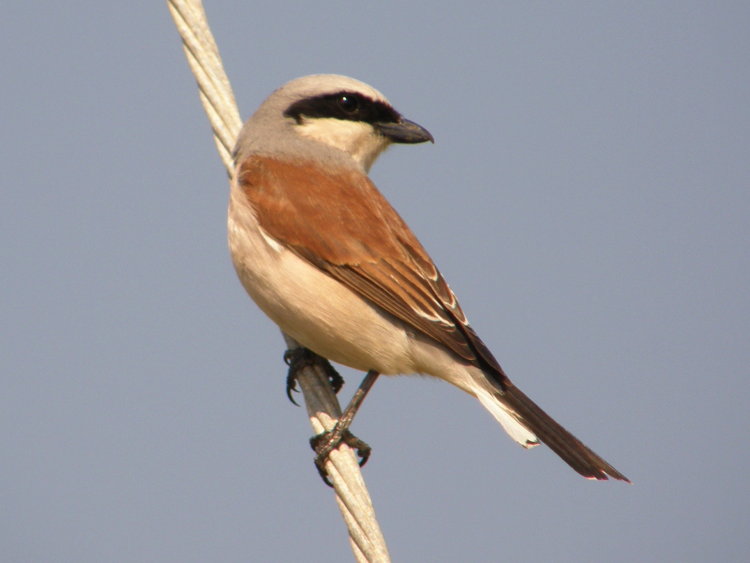 RED BACKED SHRIKE |
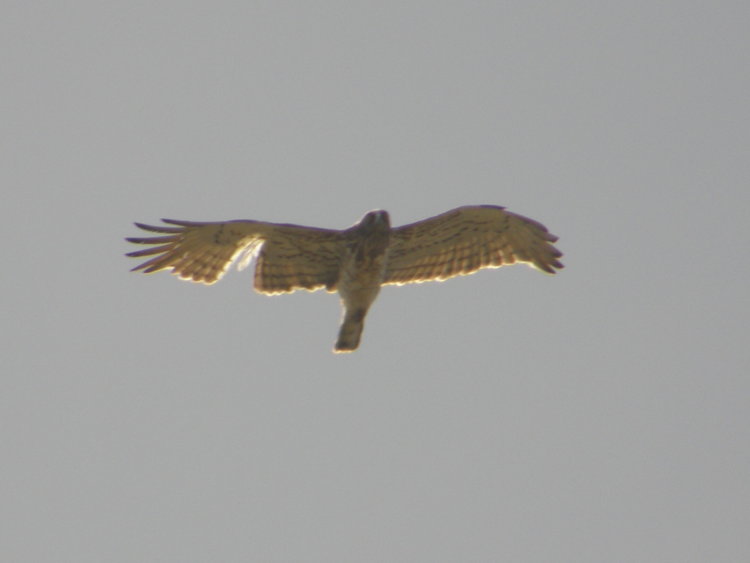 SHORT TOED EAGLE |
 BEEEATER |
|
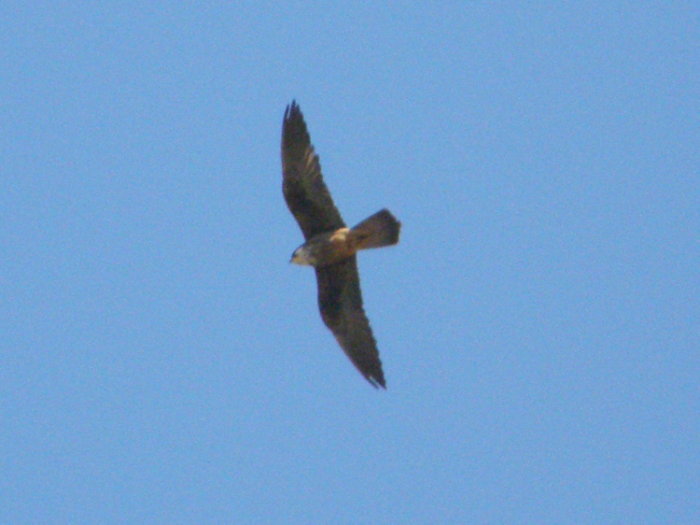 ELENORAS FALCON |
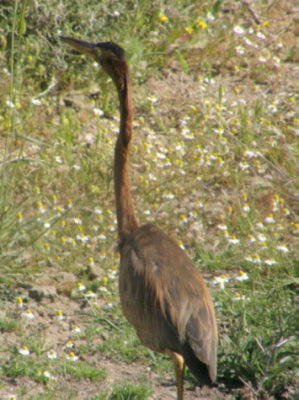 PURPLE HERON (JUVENILE) |
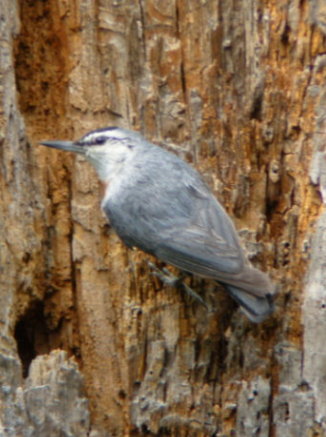 KRUPPERS NUTHATCH |
|
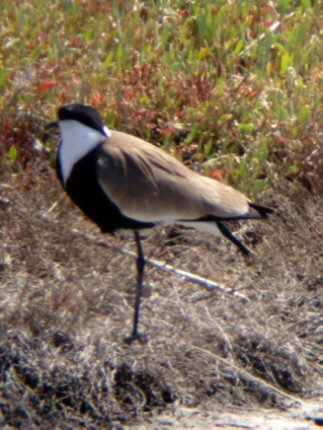 SPUR WINGED PLOVER |
|||
Despite the flight delays caused by the new Thomas Cook/First Choice partnership, once that the Manchester/Gatwick flight touched down at Miytilini and we disembarked it felt like coming home again.As we left the airport and headed inland for Anaxos, the air was filled with the heady scent of the broom that grows profusely all over the island.
Over the two weeks the weather was mostly sunny, though most days a wickedly cold wind blew from the north.
Despite the weather, we wern't to be disapointed though, since Lesvos spring 2008 birding turned out to be as good as ever. There were of course ups and downs, the Red-foots, Pratincoles and Spur-winged plovers hung around for pretty much all the fortnight.
Bee-eaters were everywhere and there was even a report of a blue-cheeked.
We had the best 2 weeks of raptors ever, with Short-toed Eagles being seen practicaly everywhere, some of which appeared to be in a very ragged state though, leading to our contemplating that they might have been shot at (or is this part of a natural process). An Imperial Eagle had been seen, which we may have run into near the Petrified Forest wind farm whilst tracking a short-toed eagle.
Earlier we also thought that we'd also got a Black Kite, but were unfortunately unable to confirm that either. Black storks were showing well and there were plenty of Little Bitterns to keep us entertained.
However we dipped on Marsh Sands and a Broad Billed Sand that had been seen on the Salt Pans Channel.
Also apart from a fleeting glimpse of what might have been a little crake in flight at the inland lake, we were unable to locate any other crakes and never heard of any being spotted either(If anyone heard of a little crake at the inland lake on Wed 14th May, it would be nice to hear from them.) Chats, bush robin and some buntings also did not seem to be as common as other years.
A greater spotted cuckoo (possibly 3) turned up near Petra reservoir, which had been drained by the way. Whilst we had been tipped off about this bird we only got to see it by accident. Our holidaying neighbour, Ian, also turned up hoping for a photo op. Although we had heard birds calling on the morning of Sat 10th May, we wern't certain that it was the birds. Ian played a recording to confirm it with us and as he did so one of the birds shot across the Sikaminia road into a bush, never to be seen by us again despite several attempts. Although we understand that two birds did put on a good display for many other birders.
Bee-eaters: were present in most sites and in good numbers throughout the two weeks although they did appear to thin out a bit the second week. At one time I estimated 50 birds flying around one area of the Salt Pans/East River fields.
Flycatchers: having seen only a single Spotted in Anaxos, numbers appeared on/after May 6th when down on the Sigri/Erresos coastal road, there was one every few yards on the walls and barbed wires. There was a female Pied Fly up at Ipsilou on 03/05 and a collared at the Sigri ford on the 6th.
Nuthatches: Western Nuthatch are present on Lesvos, we saw a pair with young up at Ipsilou in 2006, not this year however. The Krupers was showing well at Achladeri on the 4th. Whilst watching the birds near the "showers" with two other couples, a guy drove up within 3 meters of it and stuck a three foot lense out of his car. We all walked off in disgust. I've heard the arguments from photographers that a car is their hide, however they miss the point that we could all behave in the same way. In that case in Lesvos now it would mean dozens of cars at birding sites !
Raptors: Short-toed Eagles were visible at any upland sight sometimes in parties of two or three, especialy at Napi on 5th May and Sigri on 8th May. Whilst near the Petrified Forest wind farm, while tracking a STE, a large buff raptor with finger end primeries came into view and disapeared over the rocks. Long-legged Buzzards kept us entertained (we witnessed two dog fights with corvids) at Vatousa,Petri,Kalloni SP and the Kalloni raptor watch point. On the afternoon of the 2nd a Montagu's quartered the field to the right of the main drag to the salt works. Just south of Anaxos, just off the coastal path in the early morning of the 4th, a peragrine stooped from the seaward side down the valley heading east. On the 6th we were pleased to get our first Lanner on the Sigri coastal road. Red foots were present in good numbers at Kalloni Salt Pans throughout the two weeks and two females and a male were present at Sigri 0n 12th May, in a freshly mowed field. Whilst 3 lesser kestrel hovered in the "greens" field oppposite. We sighted four common buzzards at various sights, the last as we left on 15th and a female marsh harrier over the sheep fields on sun 11th. As we drove the Stipsi/Montamdamos road on 13th an Eleonora's was a welcome sighting.
A kestrel was at the Napi raptor watch point on the 5th. We also had several sightings that we couldn't identify - any help with picture 5 identification would be appreciated. Anecdotal sightings reported by others birders included: Imperial Eagle, Black Kite, Booted Eagle, Golden Eagle and Pallid Harrier.
Buntings and Sparrows: House Sparrows and Spanish Sparrows were a common sight, particularly in the scrub and arable land surrounding the Salt Pans. We found that Rock Sparrow were difficult to spot and dipped on the usual spots up at the monestry. Fortunately however on 12th May as Tina pulled up near the triangle, for good views of a Isabelline Wheatear posing on a small cairn, the fellow (rock sparrow-see record shot ) below popped up just long enough for me to snap him. At the same time a Hoopoe flew out of an adjacent small oak and minutes later a juvenile isabelline gave us a show. Regarding buntings, corn and black headed were pretty much everywhere, however we found cretzschmar's difficult this year, with the only decent views on May 6th, along the Sigri coastal road.Cinereous were also difficult but I manged the record shot below at Ipsilou on the 8th.I understand however that others faired better with the latter two species. Cirl buntings were also difficult. Although we could hear them calling on most wooded hillsides, they appeared more shy than other years and good views were hard to come by.
Egrets, storks and herons: White and black stork were showing well in the Skala Kalloni/East River/Salt Pans area throughout the fortnight. Black Stork were seen in gliding in many upland areas. We saw up three grey heron during visits to the salt pans at any one time and distant views of a spoolbill at the salt pans on 14th May. Purple heron appeared to be scarce, the only ones that we saw being the juvenile pictured below at a hill farmers rock pool near Vatousa and one at the Derbyshire on 14th where there was also a single night heron. There were also three night heron at the East River mouth on 12th May. Up to three squaccos were present at Kalloni pool for the two weeks, with singles occasionaly on the East River. The squaccos pictured flew into a channel on the Salt Pans as we arrived on1st May. Little Bitterns were easily seen down the East River, Inland Lake and other sights during our stay - the one pictured was at a rock pool in Anaxos for two weeks. Little egrets were common, although we dipped on a great egret for the first time in years. A cattle egret was reported on Kalloni pool in the middle of May, however we dipped despite several passes there. White and Black Stork were showing well in the Skala Kalloni/East River/Salt Pans area throughout the fortnight. Black Stork were seen in gliding in many upland areas. We saw up three grey heron during visits to the salt pans at any one time and distant views of a spoolbill at the salt pans on 14th May. Purple heron appeared to be scarce, the only ones that we saw being the juvenile pictured below at a hill farmers rock pool near Vatousa and one at the Derbyshire on 14th where there was also a single night heron. There were also three night heron at the East River mouth on 12th May Up to three squaccos were present at Kalloni pool for the two weeks, with singles occasionaly on the East River. The squaccos pictured flew into a channel on the Salt Pans as we arrived on1st May. Little Bitterns were easily seen down the East River, Inland Lake and other sights during our stay - the one pictured was at a rock pool in Anaxos for two weeks. Little egrets were common, although we dipped on a great egret for the first time in years. A cattle egret was reported on Kalloni pool in the middle of May, however we dipped despite several passes there. We did however get sightings at Ipsilou cross roads on 03/05,Napi valley on 05/05and Petri on 11/05. The odd ortolan was reported however we dipped.
Thrushes: Blackbirds were a pretty common sight everywhere, singing on the wires and in woodland and olive groves. Blue rock thrush were harder but were showing well at Vatousa gorge on the 6th and the Petra ruppell's site on 9th May. As anyone who goes to Lesvos knows nightingales are singing anywhere that there is leafy cover, however we got only two sightings distant at Petri on 09/05 and in very poor visability at the Kalloni Inland Lake on 14/05. We tried to twitch what sounded like a Thrush Nightingale in the lanes at Anaxos early on the morning of 14th May, but it wasn't breaking cover. The 14th followed some night time showers and was very overcast all day. Bush Robin were also late comers this year and apart from one viewed briefly singing by us at the regular "sheep fields" site on 10th May, the only other viewed was on the Sigri coastal road -a regular there for the whole two weeks.
Warblers: Again transient migrating birds were hard to come by. Regular Lesvos summer residents were generaly very obliging with Sub Alpine's and Orphean's being visible at most woodland sights - including Anaxos, Petra, Petri, Ipsilou and Molivos. The Ruppell's was displaying well at the usual "disco" site near Petra, though not as near to as some years. Unlike olivacious, who never need an excuse to pop out and give you a song, the olive tree warblers at Napi are no where near as obliging, however after half an hours patient wait there on May 5th, one popped out long enough for us and another couple to confirm a sighting. A garden warbler was at the east river on 10th May. Reed and Cetti's were showing at the East River and many other sights.This time of year in Lesvos is a good time to catch Cetti's out in the open. We had two singing lesser whitehroat on the occasions that we travelled down the Kremasti bridge track and a whitethroat singing from the telephone wires down the East River on 05/05. Other warblers were a little more difficult: On 03/05 at Ipsilou there was a black cap, chiff chaff and icterine warbler. On 06/05 we believe that we had a marsh warbler at the Sigri coastal rd ford. On 14/05 two great reeds were singing on the reed tops at the Inland Lake. We also had male and female blackcaps at other sites. Chaffinch, Goldfinch and Greenfinch were common at most locations. Linnets were seen at Ipsilou, Anaxos, Napi and Molivos. Serin were calling at Achledari, however we didn't manage to connect with a sighting. I didn't hear of any Hawfinch sightings however we have had them at napi in the past.
Chats: Stonechats were common on the Sigri/Ipsilou road, however apart from the one pictured below in Anaxos on 08/05we did not get them elsewhere. Whinchats, as far as our luck went, were also thinner than last year, having only three sightings including the one below at Faneronami on 08/05. We didn't get a northern wheatear this year however the isabelline's were showing well at the Ipsilou cross roads sight and the black eared were common everywhere during our two week stay.
Tits: Blue and Great Tits were common where there was tree cover. Sombre tits were easy to connect with, particularly at Anaxos, Napi, Petri, Sigri and Ipsilou. Although eastern race long tailed tits are present at some woodland sites, Achladeri in particular, we were unable to see any this time out.
Larks: Cresties were showing well just about everwhere for the whole of the two weeks. At least a dozen short toed larks were on the "wet meadow" opposite the salt work gates on 2nd May. A skylark was singing on the sheep fields behind the salt works on the 10th.
Pipits: The only ones that we connected with were threered throated pipits on the salt works field on 1st May and a single bird there on on 4th. We tried three times for a tawny down at Faneromeni and didn't get one, although there were reports from other people.
Wagtails: A white wagtail usualy forages on Anaxos beach, particulalrly near the inlet. A citrine was knocking about the salt works meadow during the first week, however we managed to connect with it near the East River ford on 7 May. Whilst setting up for a digi oportunity a guy in a 4 wheel drive pulled and it flew off. Flava were at Sigri on 6 May, feldegg on the sheep fields on 10th May -again didn't see anything like the numbers of wags that we have on other occasions at Lesvos.
Hoopoes, Nuthatches: Right from the off in most wooded areas, on the afternoon of 1st May in flight over the road at Petri village, we had good sightings of this evocative bird the Hoopoe, though no photo opportunities presented themselves. In particular on 5 May, there was a pair nesting in an oak tree on the Kremasti bridge road. The parent birds held off feeding whilst we'd stopped the car some 20 metres from the tree. Since they kept circling in different directions as if to distract us, we decided not to distress them further and moved on. Rock nuthatch thrive all over Lesvos in rocky upland areas. Although we they were not quite as gregarious as other years, we had sightings near the Inland lake, Napi, Vatousa Gorge and Ipsilou.
Pratincoles: Collared Pratincole were present on the Salt Works wet meadow for the two weeks that we were in Lesvos. One of our biggest thrills was watching six of them hawking for insects low over the sheep farm down the right channel from the main salt pans road. [We had sightings of MS Woods only at Petra, Inland Lake, Napi Valley and Sigri.
Rose-coloured Starlings: We were lucky enough to be at the East River Ford at about 11.30 am on 14th May when a dozen rose coloured starlings dropped into the river for a bath. As we watched from the opposite bank, they flew into a Mulberry Tree on the right hand side of the ford for a few minutes, however then flew off across the Salt Pans meadows, when people got to close.I understand they were seen again later that day in their usual Mulberry Tree down the Salt Pans track.
Doves & Pigeons: Feral pigeons can be seen as you drive through Mitilini and Kalloni. Collared doves are as common over here. Turtle doves are a little jumpy and appear to like to keep a safe distance, however we had them at Petra, Sigri, Napi and Kremasti. They can be heard cooing in woodland almost anywhere in Spring.
Swallows & Martins: As one might imagine were plentiful. I can sum this up by saying that on drive down to the Potamia valley on May 7th we were told by an aquaintance who stpped to chat not bother, because there was nothing down there. In fact the morning was dull, damp and cool and it had rained in the night. However when we got down as far as the Potamia bridge, there were hundreds of swifts, swallows and martins swooping low over the river in one of the most spectacular sights that will stay in our memories a long time. Presumably they had been forced down to lower levels by the moisture in the atmosphere. There were both red rumped and barn swallows, house and sand martins, common and alpine swifts. Needless to say the conditions also appeared to attract several raptors including common and long legged buzzard, a peregrine, two short toed eagles (one flying very low over the meadow south of the bridge) and two larger raptors that were impossible to identify in the poor light. Anaxos and Petri continue to attract red rumped swallows. Vatousa Gorge and the small dissused quary between Petri and the Stipsi Rd are still good for crag martin. We also had alpine swift regularly on our visits to the salt pans.
Owls: The Scops Owl at Kalloni is still the star of the show, however we only managed to see it on one occasion on 10 May. It tended to favour a perch on the road side of the tree, the Kalloni road is not one that you would wish to stand on for long. Little Owls were very obliging on the ruined farm build at Napi and on the Kremasti Bridge roads on 04/05 and on later visits. They were also very viewable elsewhere including the farm buildings on the hard s bend on the Sigri coastal road. Unfortunately we dipped on the Anaxos Posidon barn owl this year - I would be interested to hear from anyone who did see it. I understand that other species were reported at Skala Kalloni.
Crakes: Both a pair of moorhen and coots were present at the Inland Lake and Kalloni Pool respectively. Moorhen were also present at Parakila Marsh and in some of the Inland Lake channels. I heard of no sightings of Crakes or other rails, at any location. Other years the IL and Sigri coastal road ford have been certainties for the odd species. We would be interested to know of any sightings during the period stated.
Grebes: We only had one pair of little grebe at the IL. Again unlike other years when crested grebe have been off shore, we had none this year.
Gulls: Apart from one sighting of a single audouin's in the East River estuary on 14/05 the only other Gulls that we saw were yellow legs, although I have to confess to no great interest in them. In past years we have had slender billed both on the East River and on the Salt Pans.
Terns: One of the pleasures of Lesvos is seeing the numbers and species of terns at this time of year, with little, common, white-winged black and whiskered all being present at Kalloni Salt Pans, the East and West Rivers and Sheep Fields through out the two weeks. As we were making our final pass down the salt pans road on 15/05, we stopped the car. Whiskered and Little Terns diving, a single Gull-billed flew over the road. Black and Sandwich may occasionally also be present at this time of year.
Ducks: Up to a dozen ruddy shellduck were at the Derbyshire during our three visits there. However they could be seen almost anywhere including two birds in a field at Sigri on 08/05 and a single on the cliffs at near Petra on on 09/05. During a trek around the back of the Salt Pans (the Sheep Fields) on the 10the May, there were six (common) Shelduck viewable on the tanks.
Greater Flamingo: Greater Flamingo were present on the salt pan "tanks" in large numbers throughout the two weeks.
Waders: Avocet, black-winged stilt, curlew sandpiper,ruff and wood sandpiper were all present in the channels at Kalloni Salt Pans throughout the fortnight. Little stint and Temminck's Stint were present both here and at down the East River over the same period. On several visits to the East River we saw a common sand on each occasion. From the East Hide, on the salt tanks black tailed godwit were viewable at some in distance. Little ringed and ringed plover were also on the salt pans. One pair of little ringed decided to nest on the sand spit in the middle of the East River near the main ford and were sitting up to 13th May . We'll say nothing about the date, however between 13 - 14 am a sheep farmer unfortunately decided to run his flock downstream in the river bed. On a similar note, whilst looking for the "lion ants" that Ian Newton had tipped us off about in the Derbyshire junction area, we were surprised to find in the middle of the car park,a sitting pair of Kentish plover. One of the bird's immediately started the "broken wing" act, so we skipped the insects and left them to it. Kentish were also present on the sheep fields. Two spur wing plover were present at various locations on the salt pans for much of the two weeks. We saw a single golden plover on the banks of the SP tanks on 10/05. A curlew called as it took off from the salt marsh at the south end of the sheep fields also on 10/05/08.
Conclusion
Lesvos Spring 2008 birding was as varied, interesting and enjoyable as ever. First time visitors would have no doubt been pleased to easily view; Red Foots, Pratincole,Spur Winged Plover and Short Toed Eagle, right where they are supposed to be in "the book".
Each year sees growing interest in the island as a birding venue, particularly from a commercial birding tourist point of view.
This must lead to fears for the birds, which may in future suffer from the increased disturbance at time when they are most vunerable. Unfortunately we all want to visit during peak migration, which may overlap the breeding season, particularly for some endemic species.
In order to preserve them as a future eco asset, it must be in the interest of the Greek authorities to consider introducing some protective measures at the most "twitched" sites.
For further Lesvos 2010 updates and Links to other reports go to :
http://www.birdforum.net/showthread.php?t=170976
For the dedicated Lesvos photo site and to add your own Lesvos birding pictures please got to :
http://www.flickr.com/groups/lesvos_birding/pool/
Thanks for reading.
Best
Mick & Tina
Vernacular Name, Latin Name
Ruddy Shelduck Tadorna ferruginea
Shelduck Tadorna tadorna
Little Grebe Tachybaptus ruficollis
Med Shearwater Puffinus yelkouan
Cormorant Phalacrocorax carbo
Shag Phalacrocorax aristotelis
Little Bittern Ixobrychus minutus
Night-heron Nycticorax nycticorax
Squacco Heron Ardeola ralloides
Little Egret Egretta garzetta
Grey Heron Ardea cinerea
Purple Heron Ardea purpurea
Black Stork Ciconia nigra
White Stork Ciconia ciconia
Spoonbill Platalea leucorodia
Greater Flamingo Phoenicopterformes
Long Legged-buzzard Pernis apivorus
Short-toed Eagle Circaetus gallicus
Marsh Harrier Circus aeruginosus
Montagu’s Harrier Circus pygargus
Sparrowhawk Accipiter nisus
Buzzard Buteo buteo
Lesser Kestrel Falco naumanni
Kestrel Falco tinnunculus
Red-footed Falcon Falco vespertinus
Eleonora’s Falcon Falco eleonorae
Lanner Falcon Falco biamircus
Peregrine Falco peregrinus
Moorhen Gallinula chloropus
Coot Fulica atra
Black-winged Stilt Himantopus himantopus
Avocet Recurvirostra avosetta
Collared Pratincole Glareola pratincola
Ringed Plover Charadrius hiaticula
Spur Winged PloverHoplopterus spinosus
Little Ringed Plover Charadrius dubius
Kentish Plover Charadrius alexandrinus
Golden Plover Pluvialis apricaria
Little Stint Calidris minuta
Temminck’s Stint Calidris temminckii
Common Sandpiper Actitis hypoleucos
Curlew Sandpiper Calidris ferruginea
Ruff Philomachus pugnax
Black-tailed Godwit Limosa limosa
Redshank Tringa totanus
Curlew Numenius arquata
Greenshank Tringa nebularia
Wood Sandpiper Tringa glareola
Audouin’s Gull Larus audouinii
Yellow-legged Gull Larus michahellis
Little Tern Sternula albifrons
Gull-billed Tern Gelochelidon nilotica
Whiskered Tern Chlidonias hybrida
White-winged Black Tern Chlidonias niger
Common Tern Sterna sandvicensis
Rock Dove / Feral Pigeon Sterna hirundo
Collared Dove Columba palumbus
Turtle Dove Streptopelia decaocto
Great Spotted Cuckoo Streptopelia turtur
Scops Owl Clamator glandarius
Little Owl Otus scops
Swift Caprimulgus europaeus
Alpine Swift Apus apus
Bee-eater Apus melba
Roller Merops apiaster
Middle Spotted Woodpecker Dendrocopus medius
Hoopoe Coracias garrulus
Short-toed Lark Melanocorypha calandra
Crested Lark Calandrella brachydactyla
Woodlark Galerida cristata
Skylark Lullula arborea
Sand Martin Alauda arvensis
Crag Martin Riparia riparia
Swallow Ptyonoprogne rupestris
House Martin Hirundo rustica
Red-rumped Swallow Delichon urbicum
Red-throated Pipit Anthus pratensis
Yellow Wagtail Anthus spinoletta
Citrine Wagtail Motacilla flava
Pied Wagtail Motacilla cinerea
Rufous Bush Chat Motacilla alba
Nightingale Cercotrichas galactotes
Whinchat Luscinia megarhynchos
Stonechat Saxicola rubetra
Isabelline Wheatear Saxicola torquatus
Black-eared Wheatear Oenanthe oenanthe
Blue Rock Thrush Oenanthe hispanica
Blackbird Monticola solitarius
Cetti’s Warbler Turdus merula
Marsh Warbler Acrocephalus palustris
Sedge Warbler Locustella luscinioides
Reed Warbler Acrocephalus schoenobaenus
Great Reed Warbler Acrocephalus scirpaceus
Eastern Olivaceous Warbler Acrocephalus arundinaceus
Olive-tree Warbler Hippolais pallida
Icterine Warbler Hippolais olivetorum
Blackcap Hippolais icterina
Garden Warbler Sylvia atricapilla
Orphean Warbler Sylvia nisoria
Whitethroat Sylvia hortensis
Rüppell’s Warbler Sylvia communis
Subalpine Warbler Sylvia rueppelli
Wood Warbler Sylvia cantillans
Willow Warbler Phylloscopus sibilatrix
Spotted FlycatcherPhylloscopus trochilus
Collared Flycatcher Muscicapa striata
Pied Flycatcher Ficedula albicollis
Blue Tit Cyanistes caeruleus
Sombre Tit Cyanistes caeruleus
Great Tit Aegithalos caudatus
Kruper's Nuthatch Sitta Kruperi
Rock Nuthatch Sitta neumayer
Golden Oriole Sitta europaea
Red-backed Shrike Oriolus oriolus
Lesser Grey Shrike Lanius collurio
Woodchat Shrike Lanius minor
Masked Shrike Lanius senator
Jay Lanius nubicus
Jackdaw Garrulus glandarius
Hooded Crow Corvus monedula
Raven Corvus cornix
Rose-coloured Starling Corvus corax
House Sparrow Sturnus roseus
Spanish Sparrow Passer domesticus
Rock Sparrow Passer hispaniolensis
Chaffinch Petronia petronia
Greenfinch Serinus serinus
Goldfinch Carduelis chloris
Linnet Carduelis carduelis
Cirl Bunting Carduelis cannabina
Cretzschmar’s Bunting Emberiza hortulana
Black-headed Bunting Emberiza caesia
Corn Bunting Emberiza melanocephala
Total 133 species
Butterflies seen included :
Swallowtail
Scarce Swallowtail
Comma
Eastern Festoon
Small Copper
Orange Tip
Small White
Dappled White
Clouded Yellow
Holly Blue
Red Admiral
Southern White Admiral
Painted Lady
Large Wall Brown
Meadow Brown
Marbled white
Small Skipper
Brown Argus
and some fritillary's that I have yet to identify